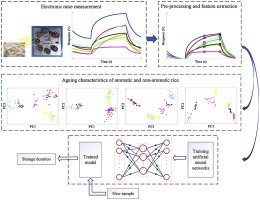当前位置:
X-MOL 学术
›
J. Food Eng.
›
论文详情
Our official English website, www.x-mol.net, welcomes your feedback! (Note: you will need to create a separate account there.)
On the feasibility of metal oxide gas sensor based electronic nose software modification to characterize rice ageing during storage
Journal of Food Engineering ( IF 5.5 ) Pub Date : 2019-03-01 , DOI: 10.1016/j.jfoodeng.2018.10.001 Hassan Rahimzadeh , Morteza Sadeghi , Mahdi Ghasemi-Varnamkhasti , Seyed Ahmad Mireei , Mojtaba Tohidi
Journal of Food Engineering ( IF 5.5 ) Pub Date : 2019-03-01 , DOI: 10.1016/j.jfoodeng.2018.10.001 Hassan Rahimzadeh , Morteza Sadeghi , Mahdi Ghasemi-Varnamkhasti , Seyed Ahmad Mireei , Mojtaba Tohidi

|
Abstract The aroma change of aromatic and non-aromatic rice was traced during storage using electronic nose (E-nose). Various steady-state and transient features were derived from the adsorption and desorption phases of the E-nose responses to characterize the ageing process and classify the storage durations. Principal component analysis was utilized to analyse the ageing in terms of seven classes related to the storage duration of 6 months. The aromatic samples followed a specific pathway in its timeline with separately distinctive grouping, revealing the reduction of ageing indices. The aromatic rice underwent crucial changes in its volatile compounds, mainly in the early stages of storage. While, confused grouping of the non-aromatic rice proved its stability due to less diverse range of the aroma compounds. Several artificial neural networks, namely back propagation (BP), radial basis function (RBF), and learning vector quantization (LVQ) were used to classify the storage durations. For the aromatic samples, full classification was achieved by using all the networks. For the non-aromatic rice, the developed RBF and LVQ networks represented full classification by using the features of rise time and polynomial curve fitting parameters. It is concluded that the E-nose system along with the developing methods could be utilized to control the rice ageing.
中文翻译:

基于金属氧化物气体传感器的电子鼻软件修改表征大米贮藏老化的可行性
摘要 使用电子鼻(E-nose)追踪香米和非香米在贮藏过程中的香气变化。各种稳态和瞬态特征源自电子鼻响应的吸附和解吸阶段,以表征老化过程并对存储持续时间进行分类。使用主成分分析法分析了与6个月储存期相关的7个等级的老化。芳香族样品在其时间线中遵循特定的途径,具有单独不同的分组,揭示了老化指数的降低。香米的挥发性化合物发生了重大变化,主要是在储存的早期阶段。同时,由于芳香化合物的多样性范围较小,非芳香大米的混淆分组证明了其稳定性。几个人工神经网络,即反向传播 (BP)、径向基函数 (RBF) 和学习矢量量化 (LVQ) 用于对存储持续时间进行分类。对于芳香族样品,通过使用所有网络实现了完全分类。对于非芳香性大米,开发的 RBF 和 LVQ 网络利用上升时间和多项式曲线拟合参数的特征代表了完整的分类。结论是电子鼻系统及其开发方法可用于控制水稻老化。通过使用上升时间和多项式曲线拟合参数的特征,开发的 RBF 和 LVQ 网络代表了完整的分类。结论是电子鼻系统及其开发方法可用于控制水稻老化。通过使用上升时间和多项式曲线拟合参数的特征,开发的 RBF 和 LVQ 网络代表了完整的分类。结论是电子鼻系统及其开发方法可用于控制水稻老化。
更新日期:2019-03-01
中文翻译:

基于金属氧化物气体传感器的电子鼻软件修改表征大米贮藏老化的可行性
摘要 使用电子鼻(E-nose)追踪香米和非香米在贮藏过程中的香气变化。各种稳态和瞬态特征源自电子鼻响应的吸附和解吸阶段,以表征老化过程并对存储持续时间进行分类。使用主成分分析法分析了与6个月储存期相关的7个等级的老化。芳香族样品在其时间线中遵循特定的途径,具有单独不同的分组,揭示了老化指数的降低。香米的挥发性化合物发生了重大变化,主要是在储存的早期阶段。同时,由于芳香化合物的多样性范围较小,非芳香大米的混淆分组证明了其稳定性。几个人工神经网络,即反向传播 (BP)、径向基函数 (RBF) 和学习矢量量化 (LVQ) 用于对存储持续时间进行分类。对于芳香族样品,通过使用所有网络实现了完全分类。对于非芳香性大米,开发的 RBF 和 LVQ 网络利用上升时间和多项式曲线拟合参数的特征代表了完整的分类。结论是电子鼻系统及其开发方法可用于控制水稻老化。通过使用上升时间和多项式曲线拟合参数的特征,开发的 RBF 和 LVQ 网络代表了完整的分类。结论是电子鼻系统及其开发方法可用于控制水稻老化。通过使用上升时间和多项式曲线拟合参数的特征,开发的 RBF 和 LVQ 网络代表了完整的分类。结论是电子鼻系统及其开发方法可用于控制水稻老化。



























 京公网安备 11010802027423号
京公网安备 11010802027423号